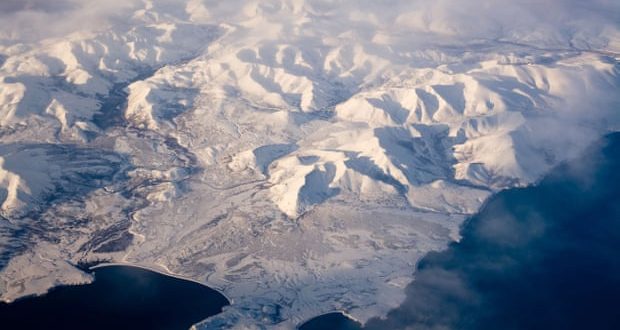Surge affects navigation and is believed to be caused by a ‘jet’ stream in Earth’s liquid outer core
Something’s up in the Arctic: the north magnetic pole is on the move. But rather than drifting around aimlessly as it has for centuries, the pole has picked up speed and is heading fast for Siberia.
The curious shift has caught scientists’ attention and forced them to take rare action. Concerned for those who navigate in the Arctic regions, they have updated the official map of the world’s magnetic field to pinpoint the pole’s location.
“We know from old ships’ logs that in the past 400 years, the north magnetic pole has hung around northern Canada. Until the 1900s, it moved perhaps tens of kilometres, back and forth,” said Ciaran Beggan, a geophysicist at the British Geological Survey in Edinburgh.
“But in the past 50 years it started to move north, and in the past 30 years it started to accelerate away,” he said. “It went from moving at about five to 10km [ six miles] a year to 50 or 60km a year today. It’s now moving rapidly towards Siberia.”
The World Magnetic Model (WMM) tracks the positions of Earth’s magnetic poles. Funded by the US and UK military, the model is normally updated every five years. But the next update, scheduled for next year, has brought forward because of north magnetic pole’s recent movements.
“We’d realised that particularly up around the north magnetic pole, the errors in the model had become too large for it to be useful,” said Beggan, who works on the model.
The wandering pole mostly affects those navigating in the Arctic. If GPS systems fail, pilots on planes and ships fall back on compass navigation and so need up-to-date maps on their onboard computers. At high latitudes, the US military has named airport runways after their direction in relation to magnetic north, and changes them whenever the poles move. For example, the airport in Fairbanks, Alaska, renamed the 1L-19R runway 2L-20R in 2009.
A similar map based on the WMM is used by smartphones and car satnavs to work out what direction they are facing. But below the northern tip of Scotland, at latitudes lower than about 55 degrees, the pole’s recent movement does not make a drastic difference.
“The correction is only a fraction of a degree and most sensors are only accurate to within a few degrees to begin with,” said Beggan.
For most WMM users, the difference between the old model and the 2019 version would be barely perceptible, he said. “It’s mainly for people who need very accurate measurements, particularly if they are going up to the north pole.” While the north magnetic pole marks the northern focus of the planet’s magnetic field, the geographic north pole marks the northern tip of the axis Earth rotates around.
The pole’s recent travels are believed to be caused by the formation of a narrow stream, much like the jet stream in the atmosphere, in the Earth’s liquid outer core. The iron-nickel core is so hot that it flows like water, 1,869 miles (3,000km) beneath the surface, creating the magnetic field and dragging it around the planet.
“The north magnetic pole has been caught up in this jet and it’s pushing it rapidly across to Siberia,” said Beggan. The south magnetic pole is moving far more slowly than the north, because the liquid outer core is moving differently in the southern hemisphere.
At the moment, Earth’s magnetic field is growing steadily weaker, leading scientists to think it will eventually flip, with the north and south poles changing places like a bar magnet flipping over. Researchers know from traces left if rocks that this has happened before, but not in the past 780,000 years.
“It’s not a question of if it’s going to reverse, the question is when it’s going to reverse,” said Daniel Lathrop, a geophysicist at the University of Maryland. Such a flip would not be instantaneous, but would take 1,000 or more years to play out.
Lathrop believes the flip will come sooner rather than later because of the weakening of the magnetic field and the fact that an area in the south Atlantic has already reversed beneath Earth’s surface.
Beggan said the magnetic field’s movement, and the rise and fall in its strength, are all part of its natural behaviour. In the long term, he said the movement of the north magnetic field could become noticeable because it affects where aurora, such as the northern lights, can be seen. “The aurora is centred around the north magnetic pole in a ring, so as the pole moves, the aurora will follow it,” he said.
The Guardian
 Lebanese Ministry of Information
Lebanese Ministry of Information



